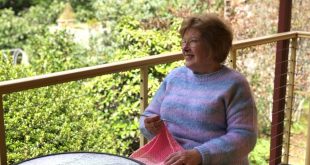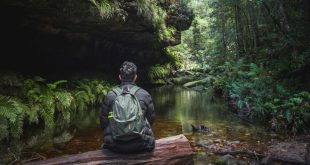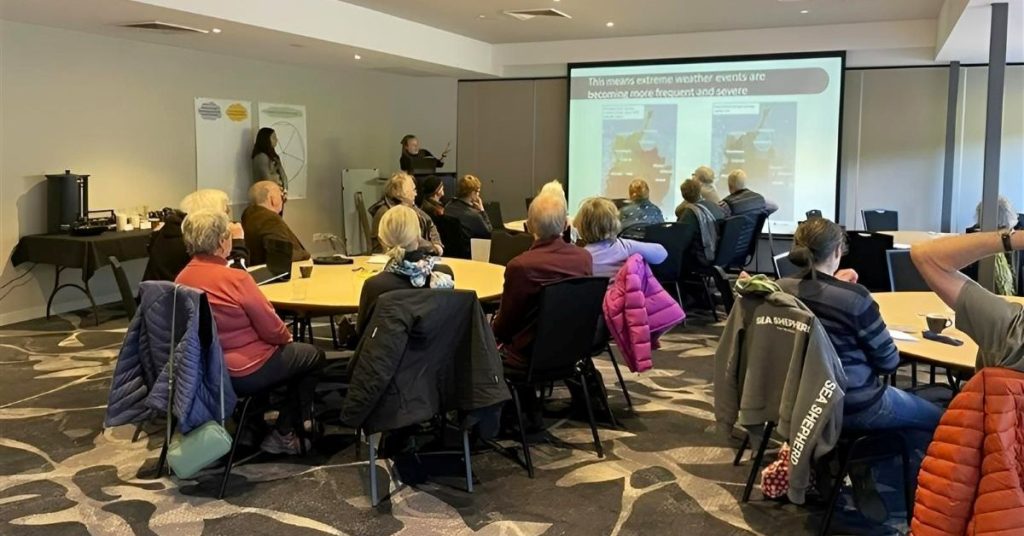
Blue Mountains residents were invited to Springwood to consult and suggest ideas for a Community Climate Risk and Adaptation Plan (Photo: Gabiann Marin)
Story by Gabiann Marin
Recently I attended a consultation day with Blue Mountains City Council to discuss a new Community Climate Risk and Adaptation Plan and the ways in which it could be implemented. I went as a resident and someone concerned about the future we are leaving on this planet, and a strong believer in the power of local change to have global effects. What transpired renewed my belief in our community, our council and our shared future.
Key Points:
- Blue Mountains City Council has held several consultations with the local community to get feedback and ideas for a Community Climate Risk and Adaptation Plan.
- The consultation day in Springwood was open to all residents and resulted in an array of ideas, talking points and connections from all involved.
The event room at Springwood Sports Club was filled with chatter as people from all over the Mountains came together to help plan and discuss pathways towards building a more resilient future for us all. Even as someone who has experienced how much the community cares about our natural environment and a positive future in the face of climate change, I was surprised to find so many people, of diverse backgrounds and opinions, heeding the call put out by the Council to help them create a feasible and effective climate risk assessment and adaptation plan.
That so many people were willing to give up their Saturday was inspiring, but more was yet to come as each small round table erupted into excited discussion when the facilitator of the day presented questions and prompts for workable solutions and community involvement. This was no top-down information sharing – it was a fully interactive space which had been designed for open and positive exchange of ideas and insights.
Scattered around the room on four large tables were markers, pens, stickers and reams of butchers paper for the groups to note down thoughts and ideas. The session was presented by Alex Dudley, climate and resilience analytics specialist and senior project manager at Resilient Co., an emergency management and climate resilience consultation agency which has facilitated similar groups across local government areas in Victoria and NSW. This, she told us, was the first time she had presented a version of the immersive consultation style event in the Blue Mountains.
“I’m so impressed by how positive and proactive everyone here is,” Alex remarked as the participants all moved around the room, adding suggestions for environmental, economic, social and cultural approaches to creating a more resilient local area.
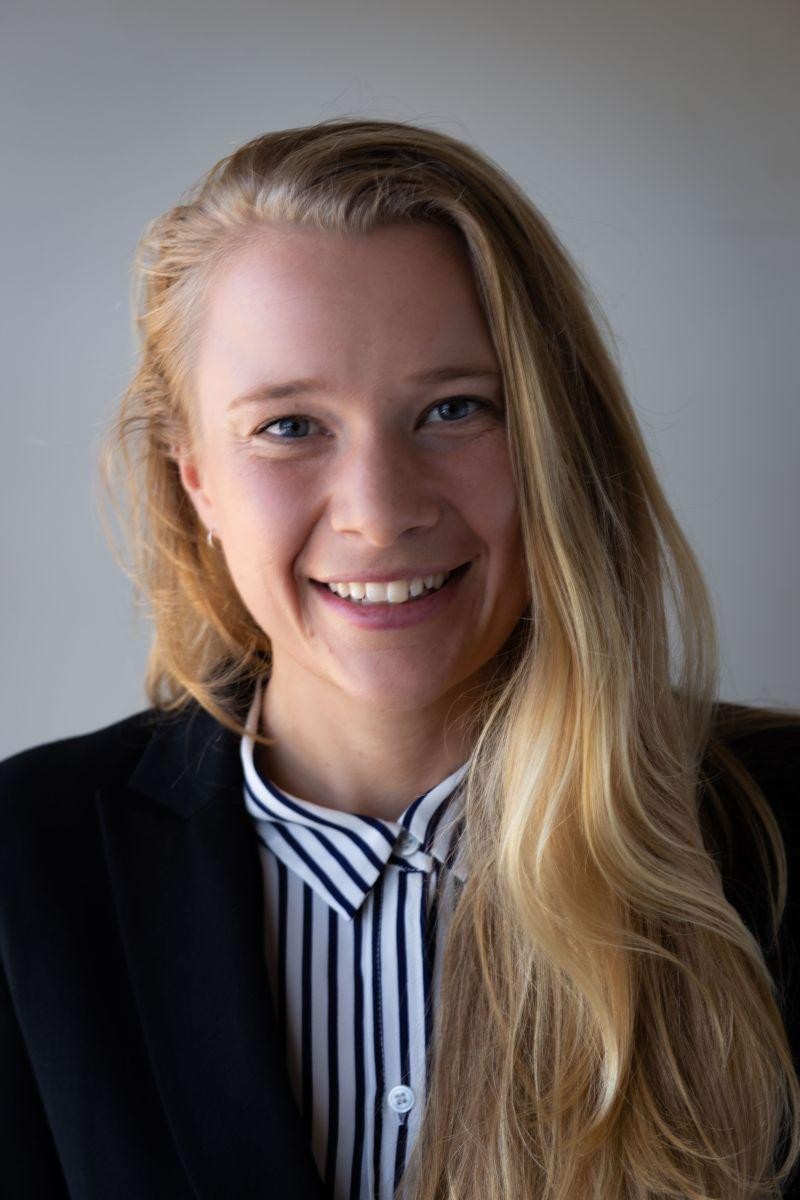
Alex Dudley, Senior Project Manager for Resilience Co. led the interactive workshops (Photo: A. Dudley)
The positivity was helped by the process of the day itself – which started with the most important question of all. What do you love about living in the Blue Mountains? Answers ranged between the sense of community, access to nature and the relief of getting out of the frantic pace of the bigger towns and cities like Penrith and Sydney.
What came up repeatedly was that the national park, its environment and the animals which make it their home, are an important and valuable benefit of living in this unique part of the world. Everyone there had some sense of the need to protect and conserve that.
By starting the day here, everyone was settled into a strongly positive mindset, clear about what it is that they wanted to conserve, save or protect and this meant that the interactions were mostly proactive and positive. Of course, at an event that is in response to an unfolding climate emergency, in a place which often bears the brunt of bushfires, landslides and other natural disasters, there had to be talk about the environmental threats and the concerns we held for our homes and the land in which we lived.
Identifying these threats was done as an interactive exercise with each group looking at different aspects of the community and the landscape and discussing what were the biggest problems going forward. It could have derailed there, I have often seen that happen, but it didn’t. Whether it was due to excellent facilitation, or just the mindset of the people who attended, each problem was approached pragmatically.
There was no denial of the issues but there was a lack of cynicism and doomsaying that often accompanies such activities. The problems, although significant, were framed in a way that was solution-based. And that is what set this day apart from so many climate change events which I have attended.
The groups quickly moved onto solutions and suggestions to help the community to adapt in the face of increasing natural disasters in the next 10 years: a proposal that may seem quite ambitious but is showing some results within the overall progress that the council members and staff have already put in place.
BMCC’s Community Climate Risk and Adaptation Plan
The Community Climate Risk and Adaptation Plan has been developed over a series of consultations with experts, local government representatives and community and will include a prioritised list of actions designed to adapt and respond to climate risks.
The development of this Plan was identified as a priority action in Council’s Towards Net Zero Plan 2024.
This plan, released as a document in 2024, is summed up in seven key approaches:
- Reach net zero emissions in a way that is just, fair and doesn’t leave anyone behind.
- Support each other to lower emissions by promoting connectedness and resilience.
- Increase health and wellbeing by reducing polluting emissions and strengthening community.
- Prioritise initiatives that reduce emissions as well as reduce costs for residents.
- Honour the wisdom of First Nations People in Caring for Country.
- Seek opportunities for emissions reduction projects to grow the local economy.
- Embed a circular economy by focusing on avoid, reuse, recycle – and landfill as a last resort.
These goals share a defined connection – the importance of the community as a key stakeholder in the entire process. This is not something anyone can achieve alone and the council seems very aware of the importance of actively and continuously offering real opportunities for all of us to have a say, get involved and lend our knowledge, expertise and experience to the overall process.

Blue Mountains City Council’s Towards Net Zero plan has a mid-term goal of 45% carbon emission reduction by 2030
One Blue Mountains resident summed up the feeling when he remarked, “We can’t just leave this to council, and then whinge because we aren’t getting what we want; we all need to be working together.” This comment was greeted with a surprising round of agreement. Everyone in that room was aware that we shared responsibility for the local area we lived in.
I am constantly reminded of how much knowledge and expertise there is within our community. People here have withstood catastrophic bushfires, have invested their own resources into bush care, land management and wildlife preservation and protection. They have fostered strong community connections and value resilience and cooperation within the villages in which they live, as well as with the local government that oversees the services they need.
As a storyteller for the Blue Mountains Planetary Health Initiative, I have been blessed to hear the stories of so many over the years who are making small and large differences. Yet in this room something close to alchemy was occurring. Those individual experiences and ideas were coming together to create innovative and feasible solutions and approaches to creating a world we all want to live in.

Participants discuss proactive solutions and ideas at the community event (Photo: BMCC, used with permission)
Sitting at my table was Lyn, a member of Resilient Blue Mountains which is a small community-led initiative working to unite different community and environmental groups to create change across the sometimes disconnected villages of the Upper and Lower Mountains.
The recent Sustainability Festival was just one of the great projects they have created. We also had a seasoned RFS volunteer and SES coordinator who understood the challenges and logistics of clear and present climate dangers and was able to inform our response with constructive first-hand information. Sitting on my other side was a community member interested in solar energy options, one of many throughout the room who were keen to engage with renewables but were unsure how best to approach the changeover.
Throughout the room people with engineering, animal welfare, bush regeneration, public relations, administration and community advocacy experience were able to share their insights, along with those who had interest and ideas but often lacked the platforms or opportunities to discuss their concerns or potential solutions.
Community-led solutions
By the end of the day there were five huge posters full of proactive ideas to address a variety of problems, from feral and invasive species to bushfire resilience to emission reductions, to community advocacy.
Some of my favourite ideas were also the least expected. Jeni, a first-time participant suggested changing the name of the Great Western Highway as it travels through the Blue Mountains to the Great Mountains Road – subtly changing the attitudes of those who crossed the Mountain to one of understanding and respect for this unique natural environment. This led to a greater discussion about better public transport and less reliance on cars and fossil fuels for getting around.
Another great suggestion was a community advisory board set up as a continuous and open way for Council to get community feedback and ideas. Others suggested more cooperation across other LGAs to help spread good ideas and initiatives beyond the fringes of the national parks, sharing ideas and learning from Lithgow, Penrith and greater Sydney shires.
Connecting all the different organisations and community groups was another well-regarded suggestion. Renewable energy was perhaps the most popular discussion point, with communities wanting a shift from simple individual solar conversions to introduction of community solar batteries and solar gardens to help share solar across communities rather than focussing on individual households, something that the Council has already begun to explore with its Community Solar and Batteries project.
Similar community-based composting and waste ideas were also shared and widely embraced. Support for better home insulation, pumped water systems and more education and oversight on the use of pesticides and herbicides were also key talking points.

Solar sharing was a popular discussion topic on the day (Illustration: Creative Commons)
By the end of the day everyone felt heard and the suggestions, concerns and ideas were all carefully recorded to incorporate into the next stages of planning, not just for the Community Climate Risk and Adaptation Plan but for myriad council and community initiatives.
The positive vibe and important connections made on the day continue to play out. Resilient Blue Mountains has upped its volunteer drive and has welcomed a number of new interested members, while many of the participants continued the conversations with those they met on the day, potentially resulting in some innovative and accessible events, groups and implementation of some of the smaller more feasible community ideas.
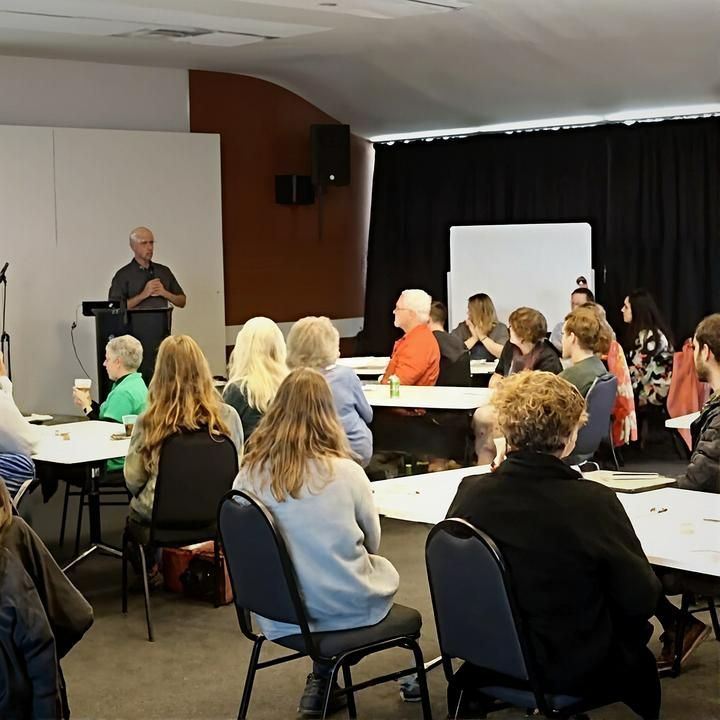
The event followed on from previous consultations held throughout 2023 and 2024 (Photo: BMCC)
Take Action:
- Resilient Blue Mountains are actively looking for volunteers and are interested in any ideas or projects which it can help facilitate. You can contact them here: Resilient Blue Mountains
- If you want to know more about the BMCC Community towards Net Zero Plan you can access their 2024 document here >
- Visit the BMCC Sustainability and Resilience Hub: a great place to find out about resources, local organisations, local initiatives or add your ideas. You can find out more here: Sustainability and resilience hub




